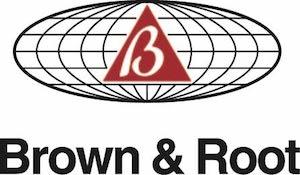Brown & Root Company

1919 saw brothers George and Herman Brown work together with their brother-in-law Dan Root to start a road building construction company in Texas. Their first major contract was to re-build four bridges in central Texas. Building on the success of this project, they were able to open an office in Houston.
The company was growing steadily until the great depression decimated it as there were no government contracts being issued. Dan Root passed away, his death blamed on the impact of stress caused by work troubles, including having to lay off most of their employees. The company looked for other work and secured a contract with a Louisiana oil company called Humble Oil. This was the first project the company did outside of Texas and was the start of a long and profitable relationship with the corporation.
As a side note, Humble Oil owned another company that would later become intertwined with Brown & Root, the Halliburton Oil Well Cementing Company.
The project that put Brown & Root on the map was the construction of the Colorado River Marshall Ford Dam. The project took from 1936 until 1941, with Brown & Root installing over two million tons of concrete. Engaging in this project established the company as a player in the heavy construction industry, worthy of being granted other large-scale government contracts. Brown & Root was then chosen to build a Naval Air Station in Corpus Christi, Texas. It is said that the Brown brothers donated large amounts of money to the political campaigns of Lyndon B. Johnson (LBJ) and in turn LBJ funneled government contracts their way.
Preparing to enter WWII, the federal government requested that Brown & Root build four submarine chasers. Brown & Root, at that time, had no shipbuilding experience, still they jumped at the opportunity and formed Brown Shipbuilding. By the time the war ended Brown Shipbuilding had built over 400 military vessels. At that time asbestos insulation was required on all Navy vessels.
Post war, the company turned its energies to designing and building off shore oil platforms and other large-scale building projects, including but not limited to, hydro-electric power plants, pulp and paper mills and car assembly factories.
Brown & Root in Canada
Brown & Root established offices in Edmonton, Alberta and Toronto, Ontario in 1951. From that time to the present they have built over 450 projects from oil platforms off the coast of Newfoundland, to hydro- electric generating stations in British Columbia. If Brown and Root were involved, the project was large and employed thousands. We have worked with steamfitters, insulators, concrete workers and welders that worked on Brown & Root projects across Canada that have subsequently developed mesothelioma.
Halliburton Ownership
In the early 60s the Halliburton (Oil Well Cementing) Company approached the Brown brothers with an offer to buy the company. As Herman Brown’s health was failing, a deal was struck, and the sale was finalized in 1962. Halliburton wanted to align itself with companies that were also anti-union and that branched into business areas outside of the oil and gas industry. At that time the only oil work Brown & Root did was build the platforms while partnering with Halliburton to do the drilling.
Together Halliburton and Brown & Root were extremely successful. Brown & Root was raking in corporate business in off shore oil drilling platforms together with government mega-projects that included the Houston, Texas, Johnson Manned Spacecraft Center. Halliburton was awash in cash from the booming oil business in both Texas and Alberta. By 1980 the company employed 110,000 workers. Shareholders were thrilled with their investment and the stock hit an all time high in November of 1980.
Halliburton fell on hard times in 1985 when the oil glut caused the price of oil to fall by 70% in the space of 5 months. The company lost $515 million in 1986 and over 50,000 lost their jobs between 1986 and 1990. Halliburton was hemorrhaging money and were desperately trying to consolidate divisions and streamline their operations to stay afloat.
In a desperate bid to secure overseas business that they needed to survive, career politician Dick Cherney was hired to run the company. The theory behind the hire was that he had contacts within foreign governments who needed power plants and other projects that Halliburton could build. He was meant to be a global salesman for the company while the running of the corporation was left to others. In a surprise move, in May of 1997 Cherney fired long time Brown & Root CEO Tommy Knight. He then appointed a president who had even less experience than he did at running a global corporation.
Cherney made many unpopular changes during his five-year tenure running Halliburton. The larges blunder, however, was the purchase of Dresser Industries for $7.7 billion in 1998. The purchase was achieved in very quick order with the shareholders approving the purchase having never been apprised of the elephant in the room; asbestos liability.
In 1998 asbestos litigation should have been a foreseeable issue for any experienced company management. Dozens of companies had already filed for bankruptcy over the crisis. 66,000 claims had been filed against Dresser at the time Halliburton purchased the company.
While Dresser was the straw that broke the camel’s back, Halliburton was already defending asbestos liability claims filed against Brown & Root. Due to the slow maturation of mesothelioma, the number of claims against Brown & Root had not yet reached the peak and in 1998 Halliburton was able to settle claims as they arose.
Under Cherney’s watch Brown & Root was forced to merge with engineering company M. W. Kellogg in 1998. The new company was christened KBR and is still in business today, although no longer owned by Halliburton.
Company Reorganization
Brown & Root projects historically used many asbestos products and put all construction workers at risk. Mesothelioma can result from as little as one day of exposure. When Halliburton realized in 2001 that they were not going to be able to pay all the injury claims and stay in business, they started negotiating a bankruptcy plan. All claimants, through their lawyers, were asked to vote on a reorganization plan in late 2003. The plan passed with 97% of Plaintiffs agreeing that something was better than nothing if the company folded. The plan provided for over $5 billion to pay current and future claimants an equal percentage of their assessed claim value.
Following the courts approval of the plan to channel all asbestos claims to the Halliburton asbestos trust in 2004, all claims against Brown & Root for injury caused by asbestos exposure are barred. This means that the company is protected by setting up an asbestos trust that assesses and pays all asbestos injury claims where exposure occurred prior to December 31, 1982.
If you worked on a Brown & Root project or later at a facility that Brown & Root built, and are now suffering from mesothelioma, contact us to discuss making a claim to the Halliburton Asbestos Trust who fund claims for Brown & Root company asbestos liability.








